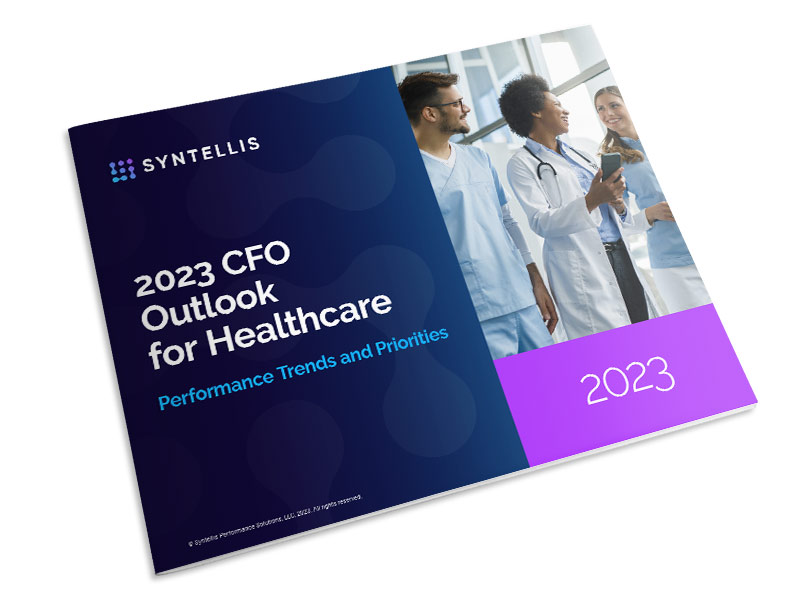U.S. healthcare leaders said addressing labor challenges is the top priority for their organizations in 2023 after workforce shortages strained healthcare providers nationwide and contributed to a very difficult 2022.
An overwhelming 98% of healthcare leaders identified workforce optimization and productivity monitoring as a leading priority for 2023, according to an annual Syntellis survey of more than 200 finance professionals from U.S. hospitals, health systems, and other healthcare organizations featured in the 2023 CFO Outlook for Healthcare report. That includes 67% who said it was a top priority and another 31% who ranked it as a high priority.
Those results were up from 2022, when 56% of survey respondents indicated workforce optimization and productivity monitoring was a top priority and 38% said it was a high priority.
Data Sources Reflect a Difficult Year
It is no surprise that managing workforce issues is a growing concern for healthcare leaders. 2022 was challenging for healthcare providers as pressures associated with nationwide workforce shortages continued to mount. Organizations had to compete for a limited pool of healthcare professionals, forcing many to pay higher rates for employees and for contract labor needed to fill staffing gaps to maintain or improve patient care.
The survey found a majority of healthcare finance leaders (61%) identified contract labor as the single largest unforeseen cost in 2022, while a quarter (25%) said employed labor was the biggest unforeseen cost.
Workforce challenges drove up labor costs throughout the year. Total Labor Expense rose 7.6% from 2021 to 2022 and jumped 20.8% compared to pre-pandemic levels in 2019, pushing Total Expenses up 5.7% from 2021 and 17.5% from 2019.
The expense increases weakened overall financial performance, driving the median hospital Operating Margin down -4.6 percentage points from 2021 to 2022 and -3.1 percentage points from pre-pandemic 2019 levels. Healthcare data show Operating Earnings Before Interest Taxes, Depreciation, and Amortization (EBITDA) also dropped -4.6 percentage points from 2021 and -3.6 percentage points from 2019.
Healthcare Labor Problems Persist in 2023
Many of the same challenges that contributed to poor performance in 2022 are expected to continue in 2023. The repercussions of ongoing workforce shortages and rising costs remain major concerns. Asked which issues keep them up at night, healthcare leaders cited their top three concerns as:
- Employed labor (67%)
- Contract labor (61%)
- Inflation (55%)
Despite the challenges, most healthcare leaders are optimistic about their organizations’ ability to navigate shifting market conditions. Eighty-nine percent of survey respondents said they are either somewhat or very confident in their team’s ability to adjust strategies as market and business circumstances change. Those results are down slightly from 92% in 2021 but up from 83% in 2020.
At the same time, many acknowledge they continue to operate with outdated tools and processes, and more than three-quarters (78%) said their organizations are not doing enough to leverage financial and operational data using healthcare data analytics solutions for effective decision-making.
Healthcare Data Are Key to Improving Labor Performance
The industry’s labor challenges are not expected to ease anytime soon. Healthcare leaders must remain focused on optimizing their workforce, including monitoring and managing workforce productivity with actionable insights. Healthcare organizations need a robust healthcare analytics solution to aggregate and drill into productivity data, assess performance, identify opportunities for improvement, and tie those improvements to measurable cost savings.
To illustrate the importance of using a comprehensive healthcare analytics and benchmarking system, an analysis compared the performance of hospitals that used Syntellis’ Axiom™ Comparative Analytics versus those that did not. The analysis found the business intelligence users gained led to better 2022 results across multiple key performance indicators, including in labor expenses and productivity.
Labor Expense per Adjusted Patient Day was -2.2% lower for Comparative Analytics users versus non-users, which equated to a savings of $1.3 million for the average hospital over the course of the year. Comparative Analytics users also were more efficient in managing their workforce leveraging the analytics solution, with Worked Hours per Adjusted Patient Day about -1% lower, resulting in savings of $430,000 for the average hospital.
Read the full report here.

